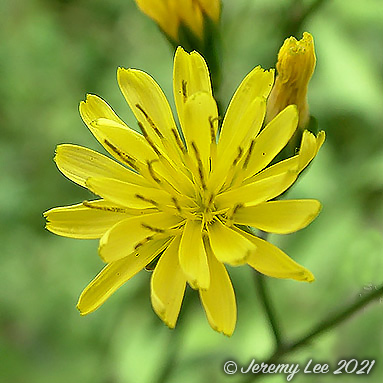
 |
|
Scientific Classifications explained » Amphibians » Ants » Aphids » Bees » Beetles » Birds » Bugs » Butterflies » Caterpillars » Damselflies » Dragonflies » Earwigs » Flies » Frog/Leafhoppers » Fungi » Galls » Grasshoppers » Harvestmen » Hoverflies » Lacewings » Ladybirds » Leaf Mines » Lichens » Mammals » Millipedes » Mosses » Moths » Sawflies » Slugs » Snails » Spiders » Trees » Wasps » Wild Flowers » Woodlice |
UK Nature > Wild Flowers > Yellow Wild Flowers > Lapsana communis

Scientific Name: Lapsana communis Common Name: Nipplewort Lapsana communis, more commonly known as Nipplewort, is a species of flowering plant in the sunflower family. It is native to Europe and southwestern Asia. and widely naturalized in other regions including North America. It is an annual or perennial herbaceous plant growing to 1 - 1.2 m tall, with erect, hairy branching stems and clear (not milky) sap. The leaves are alternate and spirally arranged; the larger leaves at the base of the flowering stem are often pinnate, with a large oval terminal leaflet and one to four small side leaflets, while smaller leaves higher on the stem are simple oval; all leaves have toothed margins. The flowers are yellow, produced in a capitulum (flower head) 1–2 cm (0.39–0.79 in) diameter, the capitula being numerous in loose clusters at the top of the stem. The eight to fifteen florets are pale yellow and shaped like a tongue with a five-toothed tip. Each has five stamens and a gynoecium composed of two fused carpels. The fruit is a cypsela surrounded by the hardened remains of the involucral bracts. The numerous small seeds are retained in the cypsela until the plant is shaken by the wind or a passing animal. Nipplewort is found growing in arable fields, woods, hedges, roadsides, wasteland, hedgerows, woodland margins and clear-felled areas in forests. |
|

https://www.uknature.co.uk is a website dedicated to showing the immense diversity of UK nature and wildlife. Our vast range of habitats, from lowland arable to snow covered mountains, from storm-ravaged coastlines to peaceful inland freshwater lakes and rivers, from dry, sandy heaths to deciduous and coniferous forests, all these habitats contribute to the abundance of UK nature. We have wild birds in huge numbers either residing or visiting our shores (597 recorded species as at July 2013) and we must also not forget the humble back garden with its grass lawns, flower beds filled with nectar rich flowers, shrubs and trees, all designed to attract huge numbers of insects such as bees, moths, butterflies and hoverflies; and finally the small ponds which provide safe havens for frogs, toads, newts and even slow worms and grass snakes. www.uknature.co.uk is the showcase for my personal passion, photographing uknature in all its glory. I sincerely hope you all enjoy the fruits of my labours. This site and all images contained therein is © Jeremy Lee 2004 - 2021. All Rights Reserved. Site design by Jeremy Lee. Site development & IT Support by Stuart Lee. |